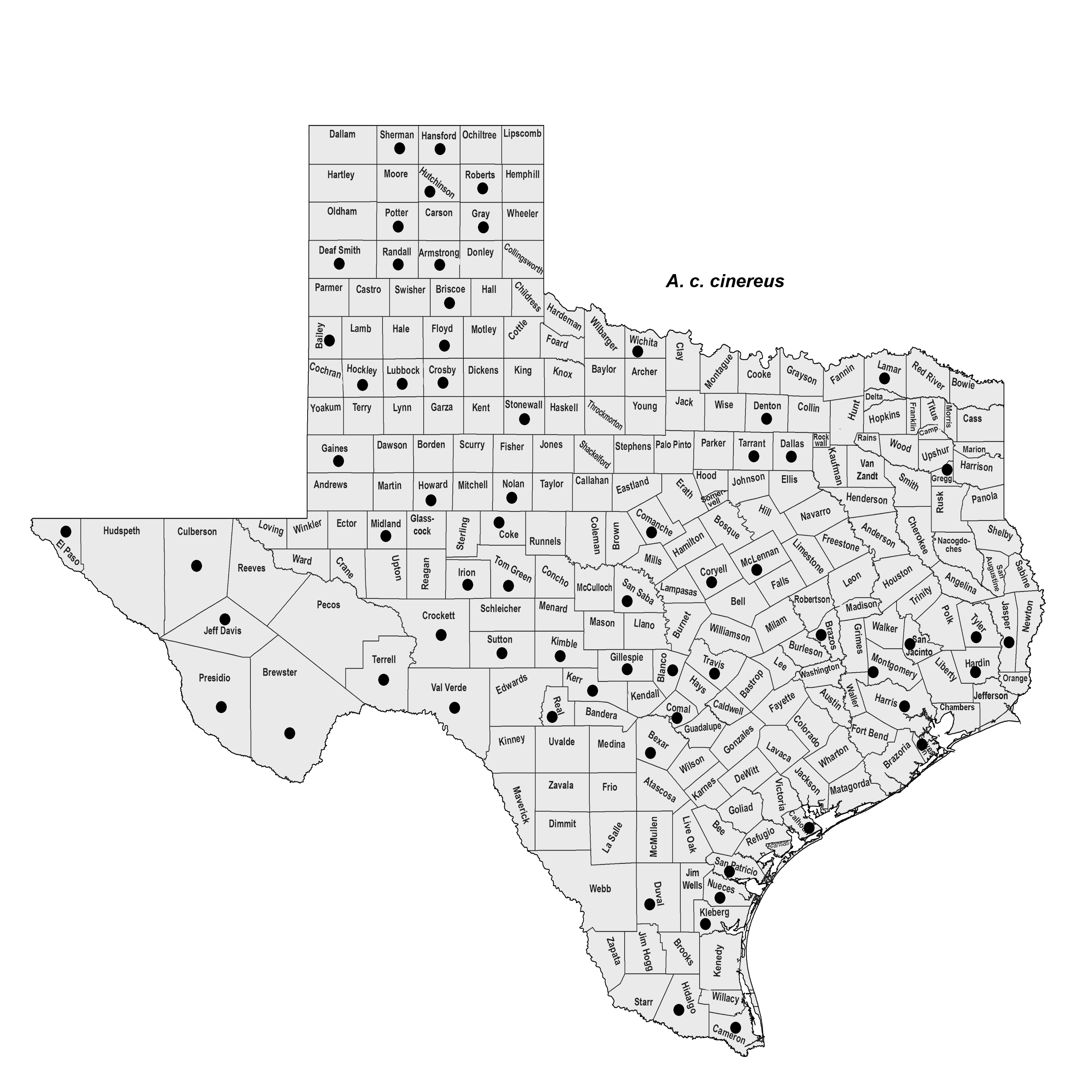HOARY BAT
Aeorestes cinereus (Palisot de Beauvois 1796)
Order Chiroptera : Family Vespertilionidae
DESCRIPTION. A large bat; ears short, rounded, and with black rims; dorsal surface of membrane between hind legs and feet densely furred; upperparts grayish or brownish, heavily frosted with white; membranes brownish black except along forearm, where they are yellowish. Not easily confused with any other North American bat. Dental formula: I 1/3, C 1/1, Pm 2/2, M 3/3 × 2 = 32. Averages for external measurements: total length, 136 mm; tail, 57 mm; foot, 12 mm; ear, 18 mm; forearm, 52 mm. Weight, 20–35 g.

DISTRIBUTION. This is a forest-dwelling, transcontinental species that has been recorded from scattered localities throughout Texas. It has been reported from all vegetational areas in the state. Males are more common in mountainous regions of the western United States, and females are more abundant in the eastern United States. Hoary bats are migratory, and the sexes appear to segregate geographically in summer.

SUBSPECIES. Aeorestes c. cinereus.
HABITS. The hoary bat typically roosts singly in deciduous or coniferous tree foliage 3–19 m (10–62 ft.) above the ground and often near the edge of a clearing. They prefer trees that are taller and larger than average in diameter and tend to roost in stands dominated by more mature trees. Like the eastern red bat, Lasiurus borealis, with which it frequently associates, the hoary bat is more or less solitary and roosts in the open by hanging from a branch or twig. It is a strong flier, and in association with other bats it is readily recognized by its large size and swift, erratic flight. This bat usually emerges rather late in the evening, but during migration it frequently is observed in daylight hours.
These bats are migratory and exhibit an interesting seasonal distribution as a result. In summer, females move to the northern, eastern, and central United States to give birth and raise their young. Males, however, remain in the western states, generally in montane areas. This pattern of migration and sexual segregation is illustrated in Texas by the distribution of this species in the Chisos Mountains of Big Bend National Park. Here, hoary bats are a rare summer resident, and only males occur in the mountains at this time. In the spring and fall, however, both males and females are found.
The primary food is moths, although they are also known to eat beetles, flies, grasshoppers, termites, dragonflies, and wasps. Apparently, the hoary bat feeds by approaching a flying moth from the rear, engulfing the abdomen–thorax, and then biting down, allowing the sheared head and wings to drop to the ground. Mating occurs during autumn migration, but implantation is delayed until spring. The usual number of young is two but ranges from one to four. In Texas, parturition occurs in mid-May into early July.
POPULATION STATUS. Common, migratory (females spring–fall; males spring–summer). This is a spring–fall migratory bat that is locally abundant at many places in the state. At this time, there appear to be no concerns about its status.
CONSERVATION STATUS. The IUCN status of the hoary bat is least concern, and the hoary bat does not appear on any federal or state lists of concerned species. However, recent studies on the impact of wind-energy facilities on bats could raise concerns about its status in Texas. Across the western United States, A. cinereus represented the highest proportion of bats killed at these facilities. This is another example of a bat that bears watching around wind turbine facilities in Texas in the future.
REMARKS. The application of the name Aeorestes for hoary bats (previously referred to Lasiurus cinereus) follows the work of Amy Bickham Baird (University of Houston–Downtown) and colleagues as described in the account of Lasiurus blossevillii.
From The Mammals of Texas, Seventh Edition by David J. Schmidly and Robert D. Bradley, copyright © 1994, 2004, 2016. Courtesy of the University of Texas Press.
Natural Science Research Laboratory
-
Address
Museum of Texas Tech University, 3301 4th street, Lubbock, TX 79409 -
Phone
806.742.2486 -
Email
nsrl.museum@ttu.edu

